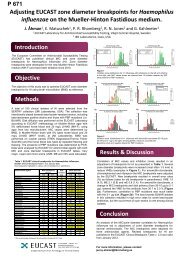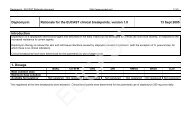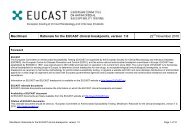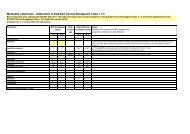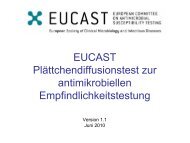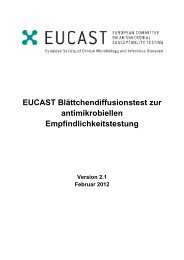Antimicrobial susceptibility testing EUCAST disk diffusion method
Antimicrobial susceptibility testing EUCAST disk diffusion method
Antimicrobial susceptibility testing EUCAST disk diffusion method
- No tags were found...
Create successful ePaper yourself
Turn your PDF publications into a flip-book with our unique Google optimized e-Paper software.
3 Preparation of inoculum3.1 Use the direct colony suspension <strong>method</strong> to make a suspension of the organism insaline to the density of a McFarland 0.5 turbidity standard (Table 2), approximatelycorresponding to 1-2 x10 8 CFU/mL for Escherichia coli.The direct colony suspension <strong>method</strong> is appropriate for all organisms, includingfastidious organisms such as Haemophilus spp., Moraxella catarrhalis,Streptococcus pneumoniae, -haemolytic and other streptococci.3.1.1 Make the suspension from overnight growth on non-selective medium. Useseveral morphologically similar colonies (when possible) to avoid selectingan atypical variant and suspend the colonies in saline with a sterile loop or acotton swab.3.2 Standardise the inoculum suspension to the density of a McFarland 0.5 standard. Adenser inoculum will result in reduced zones of inhibition and a decreased inoculumwill have the opposite effect.3.2.1 It is recommended that a photometric device is used to adjust the density ofthe suspension to McFarland 0.5. The photometric device must be calibratedagainst a McFarland standard according to the manufacturer’s instruction.3.2.2 Alternatively, the density of the suspension can be compared visually to a0.5 McFarland turbidity standard.Vigorously agitate the turbidity standard on a vortex mixer before use.To aid comparison, compare the test and standard against a whitebackground with black lines.3.2.3 Streptococcus pneumoniae is preferably suspended from a blood agar plateto McFarland 0.5. When Streptococcus pneumoniae is suspended from achocolate agar plate, the inoculum must be equivalent to McFarland 1.0.3.2.4 Adjust the density of the organism suspension to McFarland 0.5 by addingsaline or more organisms.3.3 The suspension should optimally be used within 15 min and always within 60 min ofpreparation.<strong>EUCAST</strong> Disk Diffusion Method for <strong>Antimicrobial</strong> Susceptibility Testing‐ Version 2.0 (January 2012)www.eucast.org6
Table 2Preparation of McFarland 0.5 turbidity standard1 Add 0.5 mL of 0.048 mol/L BaCl 2 (1.175% w/v BaCl 2·2H 2 0) to 99.5 mL of 0.18mol/L (0.36 N) H 2 S0 4 (1% v/v) and mix thoroughly.2 Check the density of the suspension in a spectrophotometer with a 1 cm lightpath and matched cuvettes. The absorbance at 625 nm should be in the range0.08 to 0.13.3 Distribute the suspension into tubes of the same size as those used for testinoculum adjustment. Seal the tubes.4 Store sealed standards in the dark at room temperature.5 Mix the standard thoroughly on a vortex mixer immediately before use.6 Renew standards or check their absorbance after storage for 6 months.7 Prepared standards purchased from commercial sources should be checked toensure that absorbance is within the acceptable range.<strong>EUCAST</strong> Disk Diffusion Method for <strong>Antimicrobial</strong> Susceptibility Testing‐ Version 2.0 (January 2012)www.eucast.org7
4 Inoculation of agar plates4.1 Optimally, use the adjusted inoculum suspension within 15 min of preparation.4.2 Dip a sterile cotton swab into the suspension and remove the excess fluid by turningthe swab against the inside of the container.It is important to remove excess fluid from the swab to avoid over-inoculation ofplates, particularly for Gram-negative organisms.4.3 Spread the inoculum evenly over the entire surface of the plate by swabbing in threedirections or by using an automatic plate rotator.4.4 Apply <strong>disk</strong>s within 15 minutes.If inoculated plates are left at room temperature for prolonged periods of time beforethe <strong>disk</strong>s are applied, the organism may begin to grow, resulting in erroneousreduction in sizes of zones of inhibition. Disks should therefore be applied to thesurface of the agar within 15 min of inoculation.<strong>EUCAST</strong> Disk Diffusion Method for <strong>Antimicrobial</strong> Susceptibility Testing‐ Version 2.0 (January 2012)www.eucast.org8
5 Application of antimicrobial <strong>disk</strong>s5.1 The required <strong>disk</strong> contents are listed in the breakpoint and quality control tables athttp://www.eucast.org.5.2 Apply <strong>disk</strong>s firmly to the surface of the inoculated and dried agar plate. The contactwith the agar must be close and even. Disks must not be moved once they havebeen applied to plates as <strong>diffusion</strong> of antimicrobial agents from <strong>disk</strong>s is very rapid.5.3 The number of <strong>disk</strong>s on a plate should be limited so that unacceptable overlapping ofzones is avoided. The maximum number of <strong>disk</strong>s depends on the organism and theagents tested as some agents consistently give larger zones than others withsusceptible isolates. No more than six <strong>disk</strong>s can be accommodated on a 90 mmcircular plate or 12 on a 150 mm circular plate.5.4 Loss of potency of antimicrobial agents in <strong>disk</strong>s results in reduced zone diametersand is a common source of error. The following are essential:5.4.1 Store <strong>disk</strong>s, including those in dispensers, in sealed containers with adesiccant and protected from light (some agents, including metronidazole,chloramphenicol and the fluoroquinolones, are inactivated by prolongedexposure to light).5.4.2 Store <strong>disk</strong> stocks at -20°C unless otherwise indicated by the supplier. If this isnot possible, store <strong>disk</strong>s at
6 Incubation of plates6.1 Invert plates and incubate them within 15 min of <strong>disk</strong> application. If the plates are leftat room temperature after <strong>disk</strong>s have been applied, pre-<strong>diffusion</strong> may result inerroneously large zones of inhibition.6.2 Stacking plates in the incubator affects results owing to uneven heating of plates.The efficiency of incubators varies and therefore the control of incubation, includingappropriate numbers of plates in stacks, should be determined as part of thelaboratory’s quality assurance programme.6.3 Incubate plates in the conditions shown in Table 3.6.4 With glycopeptide <strong>susceptibility</strong> tests on some strains of Enterococcus spp. resistantcolonies are not visible until plates have been incubated for a full 24h. However,plates may be examined after 16-20h and any resistance reported, but plates ofisolates appearing susceptible must be re-incubated and reread at 24h.Table 3OrganismEnterobacteriaceaePseudomonas spp.Stenotrophomonas maltophiliaAcinetobacter spp.Staphylococcus spp.Enterococcus spp.Streptococcus pneumoniaeIncubation conditions for antimicrobial <strong>susceptibility</strong>test platesStreptococcus groups A, B, C and GViridans group streptococciHaemophilus spp.Moraxella catarrhalisListeria monocytogenesIncubation conditions35±1°C in air for 16‐20 h35±1°C in air for 16‐20 h35±1°C in air for 16‐20 h35±1°C in air for 16‐20 h35±1°C in air for 16‐20 h35±1°C in air for 16‐20 h(35±1°C in air for 24 h for glycopeptides)35±1°C in 4‐6% CO 2 in air for 16‐20 h35±1°C in 4‐6% CO 2 in air for 16‐20 h35±1°C in 4‐6% CO 2 in air for 16‐20 h35±1°C in 4‐6% CO 2 in air for 16‐20 h35±1°C in 4‐6% CO 2 in air for 16‐20 h35±1°C in 4‐6% CO 2 in air for 16‐20 hOther fastidious organismsPending<strong>EUCAST</strong> Disk Diffusion Method for <strong>Antimicrobial</strong> Susceptibility Testing‐ Version 2.0 (January 2012)www.eucast.org10
8 Measurement of zones and interpretation of <strong>susceptibility</strong>8.1 For all agents, the zone edge should be read at the point of complete inhibition asjudged by the naked eye. Hold the plate about 30 cm from the eye and do not use extralighting or a magnifying glass.8.2 Measure the diameters of zones of inhibition to the nearest millimetre with a ruler,calliper or an automated zone reader.8.3 Read un-supplemented plates from the back with reflected light and the plate heldabove a dark background.8.4 Read supplemented plates from the front with the lid removed and with reflected light.8.5 Interpret zone diameters by reference to breakpoint tables at http://www.eucast.org.8.6 If templates are used for interpreting zone diameters, the plate is placed over thetemplate and zones interpreted according to the <strong>EUCAST</strong> breakpoints marked on thetemplate. A program for preparation of templates is freely available fromhttp://www.bsac.org.uk/<strong>susceptibility</strong>_<strong>testing</strong>/bsac_disc_<strong>diffusion</strong>_template_program.cfm8.7 Specific reading instructions:8.7.1 Discreet colonies growing within the zone of inhibition should be sub-culturedand identified and the test repeated if necessary.8.7.2 Antagonists in the medium may result in faint growth up to the <strong>disk</strong> withinsulphonamide or trimethoprim zones. Such growth should be ignored and thezone diameter measured at the more obvious zone edge.8.7.3 For Enterobacteriaceae with ampicillin, ignore growth that may appear as a thinfilm producing an inner zone on some batches of Mueller-Hinton agar.8.7.4 For E. coli with mecillinam, ignore isolated colonies within the inhibition zone.8.7.5 For Proteus spp., ignore swarming and read inhibition of growth.8.7.6 For staphylococci with benzylpenicillin, inspect the zone edge closely with theplate held up to light (transmitted light). Isolates with inhibition zone diameters ≥the susceptible breakpoint, but with sharp zone edges should be reportedresistant.8.7.7 When using cefoxitin for the detection of methicillin resistance in Staphylococcusaureus, measure the obvious zone, and examine zones carefully in good light todetect colonies within the zone of inhibition. These may be either acontaminating species or the expression of heterogeneous methicillin resistance.8.7.8 Read linezolid <strong>susceptibility</strong> tests on staphylococci from the back with the plateheld up to light (transmitted light).<strong>EUCAST</strong> Disk Diffusion Method for <strong>Antimicrobial</strong> Susceptibility Testing‐ Version 2.0 (January 2012)www.eucast.org12
8.7.9 For enterococci with glycopeptides, inspect the zone edge closely with the plateheld up to light (transmitted light). Fuzzy zone edges and colonies within zoneindicate vancomycin resistance and should be investigated further.8.7.10 For haemolytic streptococci on MH-F medium, read inhibition of growth and notinhibition of haemolysis. β-Haemolysis is usually free from growth, whereas α-haemolysis and growth usually coincide.<strong>EUCAST</strong> Disk Diffusion Method for <strong>Antimicrobial</strong> Susceptibility Testing‐ Version 2.0 (January 2012)www.eucast.org13
9 Quality control9.1 Use specified control strains (table 4) to monitor the performance of the test.Principal recommended control strains are typical susceptible strains, but resistantstrains can also be used to confirm that the <strong>method</strong> will detect resistance mediatedby known resistance mechanisms (table 5). These strains may be purchased fromculture collections or from commercial sources.9.2 Store control strains under conditions that will maintain viability and organismcharacteristics. Storage on glass beads at -70°C in glycerol broth (or commercialequivalent) is a convenient <strong>method</strong>. Non-fastidious organisms can be stored at-20°C. Two vials of each control strain should be stored, one as an in-use supply andthe other as an archive for replenishment of the in-use vial when required.9.3 Each week subculture a bead from the in-use vial on to appropriate non-selectivemedia and check for purity. From this pure culture, prepare one subculture on eachday of the week. For fastidious organisms that will not survive on plates for five to sixdays, subculture the strain daily for no more than one week.9.4 Acceptable ranges for control strains are shown in <strong>EUCAST</strong> Quality Control Tables.9.5 Use the recommended routine quality control strains to monitor test performance.Control tests should be set up and checked daily, at least for antibiotics which arepart of routine panels.Each day that tests are set up, examine the results of the last 20 consecutive tests.Examine results for trends and for zones falling consistently above or below themean. If two or more of 20 tests are out of range investigation is required.See <strong>EUCAST</strong> document “Quality assurance of antimicrobial <strong>susceptibility</strong> <strong>testing</strong>” forfurther details.9.6 Control strains should be tested daily until performance is shown to be satisfactory(no more than 1 in 20 tests outside control limits), at which stage <strong>testing</strong> frequencymay be reduced to once a week. If performance standards are not met, the causemust be investigated.9.7 In addition to routine QC <strong>testing</strong>, test each new batch of Mueller-Hinton agar toensure that all zones are within range.Aminoglycoside <strong>disk</strong>s may disclose unacceptable variation in divalent cations in themedium, tigecycline may disclose variation in magnesium, trimethoprimsulfamethoxazolewill show up problems with the thymine content, erythromycin candisclose an unacceptable pH.<strong>EUCAST</strong> Disk Diffusion Method for <strong>Antimicrobial</strong> Susceptibility Testing‐ Version 2.0 (January 2012)www.eucast.org14
Table 4:Quality control organisms for routine <strong>testing</strong>Organism Strain CharacteristicsEscherichia coli ATCC 25922NCTC 12241CIP 7624DSM 1103CCUG 17620CECT 434Pseudomonas aeruginosa ATCC 27853NCTC 12934CIP 76110DSM 1117CCUG 17619CECT 108Staphylococcus aureus ATCC 29213NCTC 12973CIP 103429DSM 2569CCUG 15915CECT 794Enterococcus faecalis ATCC 29212NCTC 12697CIP 103214DSM 2570CCUG 9997CECT 795Streptococcus pneumoniae ATCC 49619NCTC 12977CIP 104340DSM 11967CCUG 33638Haemophilus influenzae NCTC 8468CIP 5494CCUG 23946Susceptible, wild-typeSusceptible, wild-typeWeak β-lactamase producerSusceptible, wild-typeLow-level chromosomally mediatedpenicillin resistantSusceptible, wild type<strong>EUCAST</strong> Disk Diffusion Method for <strong>Antimicrobial</strong> Susceptibility Testing‐ Version 2.0 (January 2012)www.eucast.org15
Table 5:Additional quality control organisms for detection ofspecific resistance mechanismsOrganism Strain CharacteristicsEscherichia coli ATCC 35218NCTC 11954CIP 102181DSM 5564CCUG 30600CECT 943Klebsiella pneumoniae ATCC 700603NCTC 13368CCUG 45421CECT 7787TEM-1 ß-lactamase, ampicillin resistantESBL-producing strain (SHV-18)Staphylococcus aureus NCTC 12493 mecA positive, hetero-resistant MRSAEnterococcus faecalis ATCC 51299NCTC 13379CIP 104676Haemophilus influenzae ATCC 49247NCTC 12699CIP 104604DSM 9999CCUG 26214High-level aminoglycoside resistant (HLAR)and vancomycin resistant (van B positive)ß-lactamase negative, ampicillin resistant(BLNAR)<strong>EUCAST</strong> Disk Diffusion Method for <strong>Antimicrobial</strong> Susceptibility Testing‐ Version 2.0 (January 2012)www.eucast.org16
<strong>EUCAST</strong> Disk Diffusion Method for <strong>Antimicrobial</strong> Susceptibility Testing‐ Version 2.0 (January 2012)www.eucast.org17



